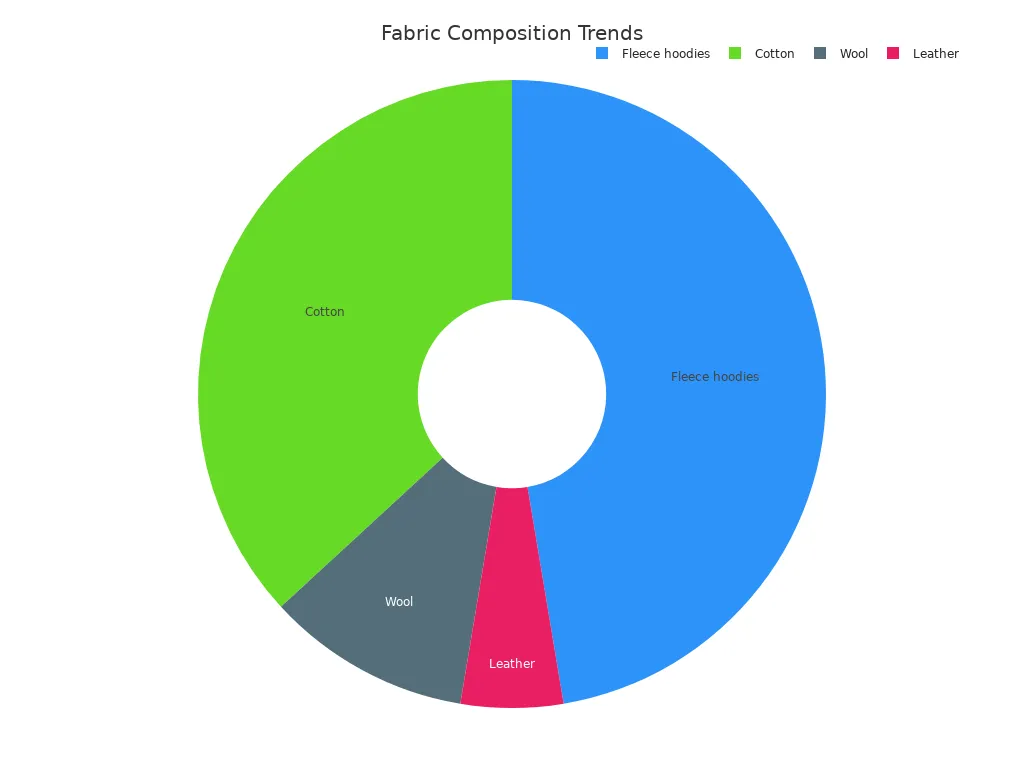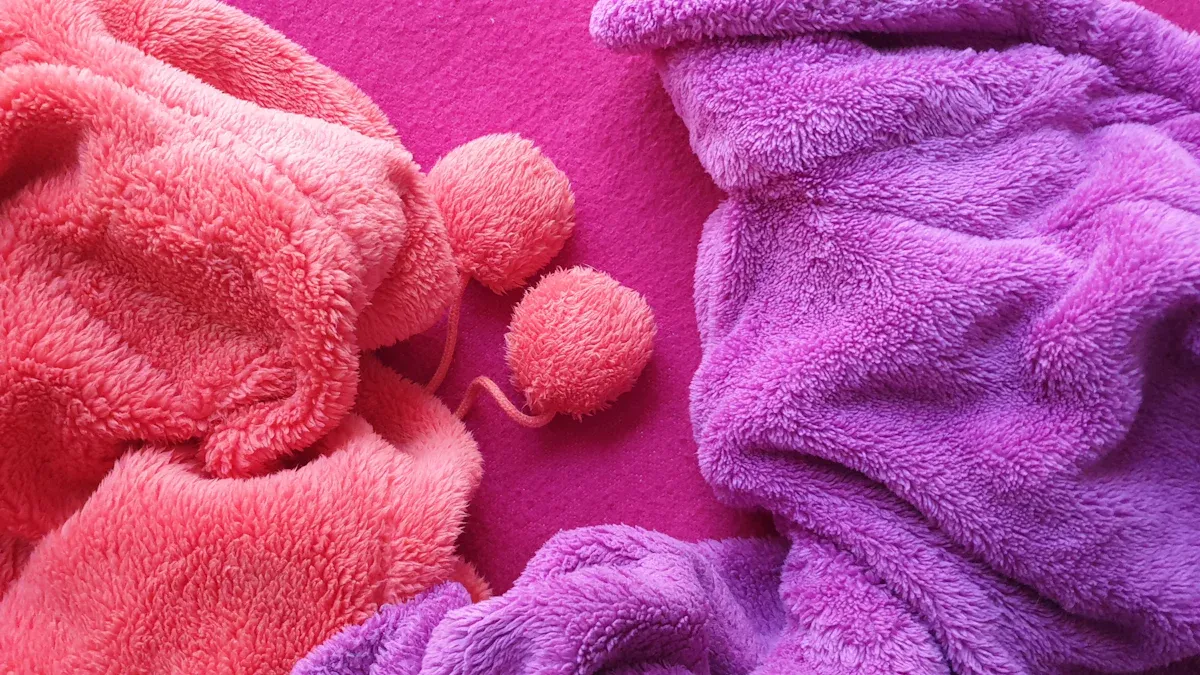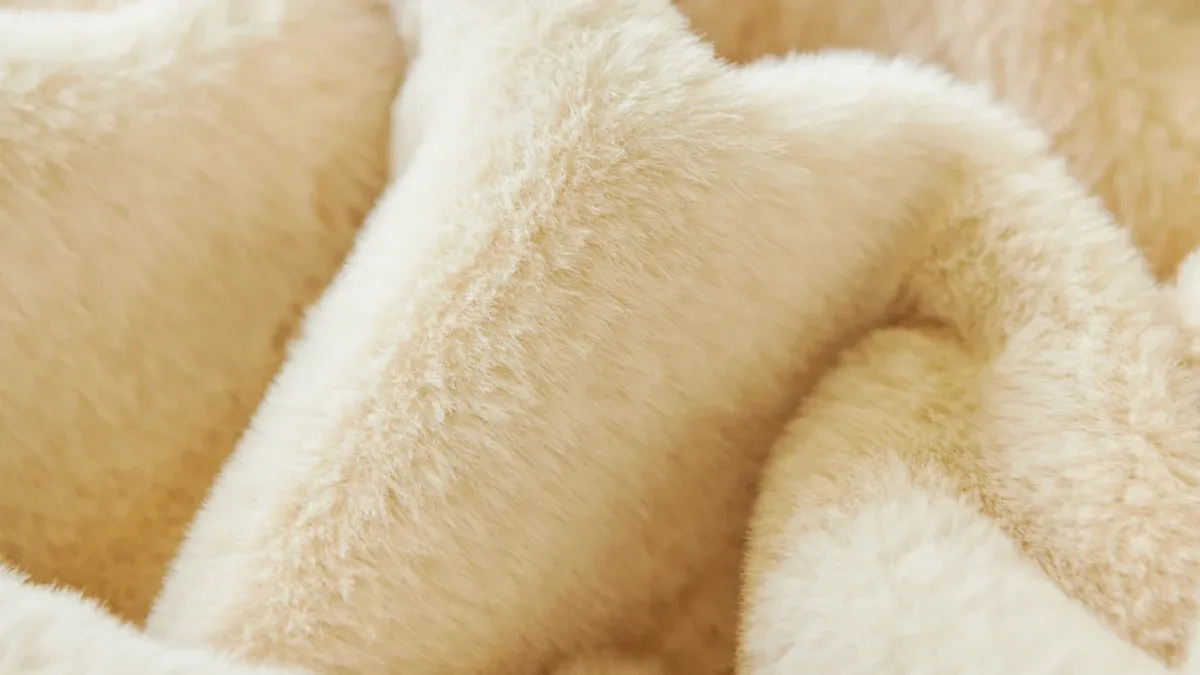
Selecting the right sweatshirt fleece fabric requires careful attention to composition and purpose. The global sweatshirt market continues to surge, driven by athleisure and comfort trends.

Consumers increasingly seek both innovation and versatility in their apparel choices.
Key Takeaways
- Choose sweatshirt fleece fabric based on your needs, such as casual wear, sports, or loungewear, considering comfort, breathability, and durability.
- Match fabric weight and type to the climate and season to stay comfortable; heavier fleece suits cold weather, while lightweight options work well in warmer conditions.
- Care for your fleece properly by washing gently with cold water, avoiding bleach, and air drying or using low heat to keep it soft and long-lasting.
Identify Your Needs for Sweatshirt Fleece Fabric
Purpose: Casual, Sports, or Loungewear
Selecting the right fleece begins with understanding the intended use. Each application—casual, sports, or loungewear—demands specific fabric qualities.
- For everyday wear, strength and ruggedness matter. Cotton and linen offer durability and comfort, making them ideal for daily use.
- Comfort and sensation play a crucial role in casual and athleisure garments. Fabrics such as cotton, bamboo, and modal provide softness and breathability.
- Fabric thickness and drape influence how a garment fits and looks. Thicker fleece adds structure, while lighter options create a relaxed silhouette.
- Sustainability and eco-friendliness have become priorities for many consumers.
- Price and supply also affect fabric selection, as buyers seek a balance between cost and consistent availability.
- Popular choices for casual and sportswear include cotton for softness and breathability, polyester for durability and quick-drying, and blends that combine comfort with performance.
Note: Sports and activewear require enhanced breathability and moisture-wicking properties. French Terry fleece, grid fleece, and microfleece help prevent overheating and manage sweat. For outdoor or performance wear, windproof or waterproof features provide protection against harsh weather. Anti-pill fleece ensures long-term durability.
Climate and Seasonality
Climate and seasonality significantly influence fabric choice. The need for insulation or breathability changes with temperature and weather conditions. The following table shows how thermal resistance varies by clothing type, reflecting the insulation required for different seasons:
| Clothing Type / Ensemble | Thermal Resistance (clo) Range | Thermal Resistance (m²K/W) Range |
|---|---|---|
| Sweaters/Sweatshirts/Jackets | 0.20 – 0.35 | 1.03 – 1.81 |
| Dresses/Skirts | 0.15 – 0.40 | 0.78 – 2.07 |
| Coats/Parkas | 0.55 – 0.70 | 2.84 – 3.62 |
| Long-sleeved underwear, shirt, pants, jacket, socks, shoes | 0.155 | 5.17 |
| Short-sleeved underwear, shirt, pants, jacket, thermal coat and pants, socks, shoes | 0.225 | 7.50 |
| Long-sleeved underwear, thermal coat and pants, padded parka, socks, shoes, hat/cap, gloves | 0.395 | 13.17 |
Thermal resistance values increase in colder conditions, so heavier fleece fabrics become more desirable in winter. In warmer climates, lightweight and breathable options help maintain comfort. Cultural and regional factors also shape clothing preferences. For example, some regions favor sweatshirts for layering, while others prioritize lighter garments due to local weather patterns.
Personal Preferences: Softness, Weight, and Stretch
Personal preference remains a key factor in fabric selection. Some individuals value a plush, soft feel, while others prefer a lightweight or structured garment.
- Softness: French Terry, plush fleece, and coral fleece offer a gentle touch, making them favorites for loungewear and casual pieces.
- Weight: Heavier fleece provides warmth and structure, suitable for colder months. Lightweight fleece ensures breathability and comfort during milder weather.
- Stretch: Fabrics with added spandex or elastane deliver flexibility and ease of movement, essential for sportswear and active lifestyles.
Moisture resistance, durability, and weather protection also influence personal choices. Anti-pill fleece maintains a fresh appearance over time, while windproof or waterproof options add functionality for outdoor activities. Matching these features to individual needs ensures the best experience with sweatshirt fleece fabric.
Types of Sweatshirt Fleece Fabric

Cotton Fleece
Cotton fleece remains a popular choice for many consumers. This fabric offers breathability, softness, and hypoallergenic properties. Cotton fleece works well for those who value comfort and versatility in their clothing. In 2024, cotton held a 45.4% market share, making it the dominant material in the sweatshirt category. Many people choose cotton fleece for its natural feel and ability to regulate temperature.
Polyester Fleece
Polyester fleece stands out for its durability and moisture-wicking abilities. Athletes and active individuals often select this fabric for its quick-drying nature. Polyester fleece resists shrinking and maintains its shape after repeated washing. While environmental concerns have slowed its growth, polyester remains a staple in sportswear due to its affordability and performance.
Blended Fleece
Blended fleece combines the strengths of different fibers, such as cotton, polyester, and spandex. These blends offer enhanced comfort, flexibility, and durability. Blended fleece accounted for 30% of sportswear sales in 2023, with a projected compound annual growth rate of 7.8%. Many brands use blended fleece to meet the demands of the athleisure trend, providing garments that move easily with the body.
Sustainable and Eco-Friendly Sweatshirt Fleece
Sustainable fleece options have gained traction in 2025. Consumers now seek fabrics made from organic cotton, recycled polyester, hemp, and bamboo. These materials reduce environmental impact and support ethical production. Sustainable sweatshirt fleece fabric offers durability and breathability while aligning with growing environmental awareness and health concerns.
Note: The table below summarizes the market share and drivers for each fabric type.
| Fabric Type | Market Share / Statistic | Notes / Drivers |
|---|---|---|
| Cotton | 45.4% market share in 2024 | Breathability, comfort, hypoallergenic, versatile |
| Blended (cotton/poly/spandex) | 30% of sportswear sales in 2023; CAGR 7.8% projected | Enhanced comfort, performance, athleisure trend |
| Polyester | Not explicitly quantified | Durability, moisture-wicking, affordability |
| Sustainable Eco-friendly | N/A (not explicitly quantified) | Organic cotton, recycled polyester, hemp, bamboo; growing demand for sustainability |
Key Features of Sweatshirt Fleece Fabric
Weight and Thickness
Weight and thickness play a crucial role in determining the comfort and function of fleece garments. Manufacturers measure weight in ounces per square yard and thickness in inches. These two factors influence how a fabric feels and performs in different settings. Heavier fleece often provides a more substantial feel, but it does not always guarantee better insulation. Some lightweight fleece fabrics deliver impressive warmth due to their advanced structure.
The following table highlights measured values for several popular fleece samples:
| Fleece Sample | Weight (oz/yd²) | Thickness (inches) | Intrinsic Clo/oz/yd² | Intrinsic Clo/inch |
|---|---|---|---|---|
| Polartec 100 9180 Double Velour MY | 8.2 | 0.247 | 0.13 | 4.3 |
| Polartec 300 Coyote RW | 10.9 | 0.155 | 0.11 | 7.2 |
Note: Testing shows that lighter fleece can sometimes outperform heavier options in thermal resistance. Fabric structure and loft contribute significantly to insulation efficiency.
When selecting a fleece, buyers should consider both weight and thickness in relation to their intended use. Lightweight fleece works well for layering or mild climates, while thicker options suit colder environments.
Warmth and Breathability
Warmth and breathability define the comfort level of any fleece garment. The ability to trap heat while allowing moisture to escape ensures that wearers stay comfortable in various conditions. Advanced fleece fabrics use specialized fiber arrangements and surface finishes to maximize insulation without sacrificing airflow.
Thermal resistance, measured as R-value or clo, provides a scientific basis for comparing warmth. Some lightweight fleece fabrics achieve high thermal resistance due to their unique construction. Infrared imaging and photomicrographs reveal that air pockets within the fabric help retain body heat while promoting breathability.
Manufacturers design fleece with different levels of warmth to suit a range of activities. Outdoor enthusiasts often prefer high-loft fleece for cold weather, while athletes may choose lighter, more breathable options for active pursuits.
Stretch and Recovery
Stretch and recovery determine how well a fleece garment moves with the body and returns to its original shape. Fabrics with added spandex or elastane offer greater flexibility, making them ideal for sportswear and active lifestyles. These materials allow for a full range of motion without losing their form.
A high-quality fleece should stretch comfortably and recover quickly after movement. This feature enhances both fit and durability. Garments that maintain their shape after repeated use provide lasting comfort and a polished appearance.
Tip: For activities that require frequent movement, select fleece with a blend of stretch fibers to ensure optimal performance.
Durability and Pilling Resistance
Durability ensures that fleece garments withstand regular wear and washing. Pilling, the formation of small fabric balls on the surface, can affect both appearance and comfort. Manufacturers use advanced finishing techniques and fiber blends to minimize pilling and extend the life of the fabric.
High-quality sweatshirt fleece fabric resists abrasion and maintains its structure over time. Testing with guarded hot plates and repeated laundering cycles helps identify fabrics with superior durability. Consumers benefit from garments that look new and feel comfortable even after many washes.
Choosing fleece with proven pilling resistance and robust construction leads to longer-lasting, better-looking apparel.
Style and Appearance of Sweatshirt Fleece Fabric
Texture: Brushed vs. Unbrushed
Texture plays a significant role in the look and feel of fleece garments. Brushed fleece features a soft, fuzzy surface created by brushing the fabric’s inner side. This process increases warmth and gives a plush hand feel. Many brands use brushed fleece for cozy sweatshirts and loungewear. Unbrushed fleece, on the other hand, has a smoother finish. It feels lighter and works well for layering pieces or activewear. The choice between brushed and unbrushed fleece depends on the desired comfort level and intended use.
Tip: Brushed fleece offers extra insulation, making it ideal for colder climates or winter wear.
Color and Pattern Choices
Color and pattern selection can transform the appearance of any fleece garment. In 2025, consumers see a wide range of options, from classic neutrals to bold, saturated hues. Tie-dye, color-blocking, and geometric prints remain popular. Many manufacturers also offer custom dyeing services for unique looks. A table below highlights trending color palettes:
| Trend | Popular Colors |
|---|---|
| Classic | Navy, Gray, Black |
| Vibrant | Coral, Teal, Lime |
| Earthy | Olive, Sand, Rust |
Fit and Drape
Fit and drape influence both comfort and style. Oversized silhouettes continue to dominate streetwear, while tailored fits appeal to those seeking a polished look. The drape of fleece depends on its weight and construction. Lightweight fleece creates a relaxed, flowing shape. Heavier fleece provides structure and holds its form. Shoppers should consider body type and personal style when choosing the right fit.
Care and Maintenance of Sweatshirt Fleece Fabric
Washing and Drying Guidelines
Proper care extends the life of any fleece garment. Manufacturers recommend gentle washing to preserve softness and structure. Use cold or lukewarm water with a mild detergent. Avoid bleach and fabric softeners, as these can damage fibers and reduce performance.
For best results, turn garments inside out before washing. This step helps protect the outer surface from friction and pilling. Machine wash on a gentle cycle.
When drying, air drying remains the safest option. Lay garments flat on a clean towel or drying rack. If using a dryer, select a low heat setting. High temperatures can cause shrinkage and weaken the fabric.
Tip: Remove fleece items promptly from the washer to prevent wrinkles and maintain shape.
Shrinkage and Colorfastness
Shrinkage can occur if fleece fabrics experience excessive heat during washing or drying. Cotton-rich blends are more prone to shrinking, while polyester-based options resist size changes. To minimize shrinkage, always follow the care label instructions and avoid hot water or high dryer settings.
Colorfastness ensures that garments retain their original color after multiple washes. High-quality fleece fabrics undergo special dyeing processes to lock in color. Wash similar colors together and avoid overloading the machine.
A simple table below summarizes key care points:
| Care Aspect | Recommendation |
|---|---|
| Water Temperature | Cold or lukewarm |
| Drying Method | Air dry or low heat |
| Detergent | Mild, no bleach |
| Color Care | Wash with similar colors |
2025 Trends and Innovations in Sweatshirt Fleece Fabric

New Technologies in Fleece
The year 2025 brings remarkable advancements in fleece technology. Manufacturers now use smart textiles that adapt to changing temperatures, providing comfort in any environment. Moisture-wicking and breathability features have become standard, making fleece garments suitable for both active and casual lifestyles. Automation and 3D knitting technologies streamline production, reducing waste and improving efficiency. Digital printing and embroidery allow for unique, personalized designs, giving consumers more choices than ever before. Waterless dyeing methods have gained popularity, cutting water usage and pollution during the manufacturing process. These innovations reflect the growing demand for versatile, high-performance sweatshirt fleece fabric.
- Smart textiles adjust insulation based on environmental conditions.
- 3D knitting reduces material waste and speeds up production.
- Digital customization enhances consumer engagement.
- Waterless dyeing protects natural resources.
Sustainable and Ethical Choices
Sustainability shapes every stage of fleece production in 2025. Brands increasingly use eco-friendly materials such as organic cotton and recycled polyester, which save energy and water. Many companies now commit to 100% sustainable sourcing, ensuring ethical practices throughout the supply chain. Collaboration with environmental organizations supports circular economy initiatives, including take-back programs for recycling old sweatshirts. Digital platforms and social media raise consumer awareness, encouraging responsible purchasing decisions. The athleisure trend continues to drive demand for stylish, functional, and sustainable options. These changes signal a fundamental shift in how sweatshirt fleece fabric is designed, produced, and consumed.
Selecting the right fabric requires careful attention to personal needs, climate, and style. Readers benefit from matching features to their lifestyle. Current trends offer new options, but long-term comfort remains essential.
For best results, review fabric qualities before making a purchase.
FAQ
What is the best way to prevent pilling on sweatshirt fleece?
Turn garments inside out before washing. Use a gentle cycle and mild detergent. Air dry or use low heat to maintain fabric quality.
How does brushed fleece differ from unbrushed fleece?
Brushed fleece feels softer and warmer. Unbrushed fleece offers a smoother surface and lighter weight, making it suitable for layering or activewear.
Are sustainable fleece fabrics as durable as traditional options?
Many sustainable fleece fabrics match traditional options in durability. Manufacturers use advanced techniques and quality fibers to ensure long-lasting performance.
Post time: Jun-18-2025